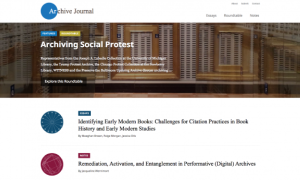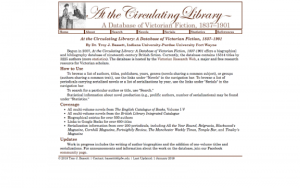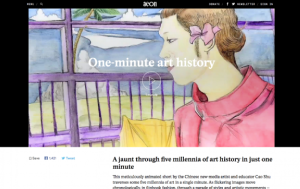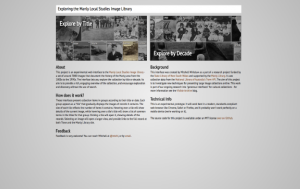Research and Education
Back to Top
|
 |
|
 |
|
Archive Journal
|
Social studies |
|
Archive Journal is a peer-reviewed journal dedicated to the "use and theory of archives and special collections in higher education." The journal is edited by a team of archivists and scholars from across the United States, including several digital humanists. Archive Journal is comprised of three sections. By navigating to the essays tab, readers will find long-form "analytical and creative pieces that reflect on meaning-making in and through archives." Meanwhile, the notes section features shorter essays about the archival world. Many of these essays highlight specific archives or projects and feature reflections about best practices or new debates and trends in the field. Finally, in the roundtable section, the journal invites a small group of professionals to respond to a series of questions related to a specific topic in the archives world. In one recent roundtable, Emily Gore and Mark A. Matienzo of the Digital Public Library of America, Aaron Devor and Lara Wilson of the University of Victoria, Meredith R. Evans of Washington University, and Joy R. Novak of the Center for the Studies of the Political Graphics, discuss the concept of "radical archives." [MMB] |
|





|
|
 |
|
Cofrin Library: Rate My Source
|
Language Arts |
|
For librarians and instructors, the University of Wisconsin - Green Bay's Cofrin Library has created this helpful interactive guide designed to help students evaluate potential research sources. This online tool guides students through the CAARP model, asking students questions about the source's Currency, Authority, Accuracy, Relevance, and Purpose via a series of multiple-choice questions. As students answer these questions, they will see feedback about what this information reveals about the reliability, authority, and usefulness of their research sources. When students complete the assessment, they also receive a general recommendation about the reliability of their selected source. As the site notes, this recommendation is designed to be used in conjunction with the user's own judgment. [MMB] |
|





|
|
 |
|
DigiVatLib
|
Social studies |
|
Founded in 1475 by Pope Nicholas V, the Vatican Library is one of the oldest libraries in the world. It hosts over one million boxes and thousands of manuscripts and codices. Since 2010, the Digital Vatican Library (DigiVatLib) has sought to "[provide] free access to the Vatican Library's digitized collections," which includes "manuscripts, incunabula, archival materials, inventories, graphic materials, coins, medals, [and] printed materials." Visitors may search this collection through a series of online catalogues or browse the collection via seven digital collections. Most items in the online catalogue and digital collections are dedicated to a specific source type (e.g. printed materials, visual materials, and coins and medals). Alternatively, visitors may also conduct a keyword or advanced search on the whole collection. DitiVatLib contains items in dozens of languages spanning from the middle ages through the twentieth century. As of this write-up, visitors can browse DigiVatLib in English, Italian, or Japanese. [MMB] |
|





|
|
 |
|
At the Circulating Library: A Database of Victorian Fiction, 1837-1901
|
Language Arts |
|
In nineteenth-century England, circulating libraries allowed subscribers to borrow books for an annual fee. English professor Troy Bassett of Indiana University-Purdue University Fort Wayne has created At the Circulating Library: a "biographical and bibliographical database of nineteenth-century British fiction" spanning from 1837 through 1901. This database, which is hosted by the Victorian Research Web, includes over 15,000 titles and includes novels from The English Catalogue of Books and the British Library Integrated Catalogue. In addition to novels, the collection also includes information about literature that was serialized in popular periodicals. Visitors may browse this database by title, author, year, or publisher. In addition, visitors can browse via a number of designated genres (which include Gothic Novel, Military Fiction, Slum Fiction, and Character: Fallen Woman, to name just a few) as well as designated groups (including American Authors, Suffragists, and Bronte Family). [MMB] |
|





|
|
 |
|
Every Week
|
Language Arts |
|
Every Week was a women's magazine published between 1915 and 1918 that featured fictional stories, advice, editorials, and advertisements. Melissa Homestead, an English professor at the University of Nebraska-Lincoln, has created this online resource that allows visitors to explore this magazine and, by extension, learn more about how the popular women's magazine that portrayed issues of gender, race, and World War I during the early twentieth century. Visitors interested in reading Every Week may do so in the browse and search sections. As the site notes, the magazine has been digitized courtesy of the University of Wisconsin-Madison. In addition, this digital collection is accompanied by six short essays about the magazine's history. Collectively, these essays help readers contextualize this publication. [MMB] |
|





|
|
 |
|
Public Libraries Online Podcast
|
Language Arts |
|
The Public Library Association's online publication, Public Libraries Online, launched a podcast in 2015 dedicated to discussing issues relating to public librarianship. The podcast is hosted by Kathleen Hughes, Manager of Publications for the Public Library Association, and features a number of guest experts. Each episode of the podcast ranges between approximately ten and twenty-five minutes in length and explores a specific topic that may be of interest to the public library community. In one recent episode, Hughes talks to John Spears, the director of the Pikes Peak Library District in Colorado, about providing services to patrons who are homeless. In another recent episode, Hughes interviews Nicholas Higgins, Director of Outreach Services at Brooklyn Public Library, about his work in providing library services to jails and prisons. Each episode of this podcast is accompanied by a list of resources for those interested in further exploring the topics discussed on this show. [MMB] |
|





|
|
 |
|

























